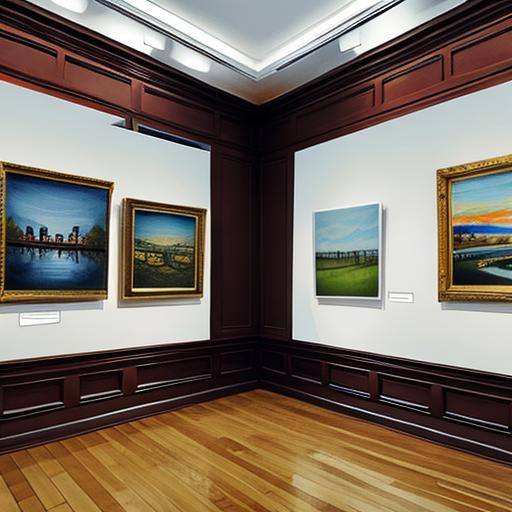Have you ever wondered who owned a famous painting before it ended up in a museum? Or how artists can prove a digital picture is the real one when copies are so easy to make? The art world has wrestled with these questions for centuries. Tracking who owned what (that’s called provenance) and proving something is authentic has often been messy. But now, a new technology called blockchain is stepping in, shaking things up and offering fascinating solutions. Getting blockchain art explained helps us understand how it’s fundamentally changing blockchain art ownership and provenance. It might sound complex, but the core idea is altering how we think about owning and trusting art, especially in the digital age.
Key Points Summary:
- What is Blockchain? It’s like a super secure, shared digital diary (ledger) that’s almost impossible to tamper with.
- Provenance Power-Up: Blockchain creates a clear, trustworthy, and permanent history record for artworks.
- Ownership Revolution: Especially for digital art, blockchain uses unique digital tokens (NFTs) to prove who owns what.
- Benefits: Increases transparency, helps artists earn royalties automatically, fights forgery, and potentially makes art accessible to more people.
- Challenges: Environmental concerns, tricky regulations, market ups-and-downs, and the tech can still be confusing.
- Future: Expect more links between physical and digital art, easier use, and new creative possibilities.
Understanding the Basics: What is Blockchain Anyway?
Before diving deeper into how blockchain impacts art, let’s get the basics of the technology itself explained. Imagine a special kind of online notebook shared between many computers. Every time something happens – like an artwork being sold – a note (a “block”) is added to the notebook. This note contains details like who sold it, who bought it, when, and for how much.
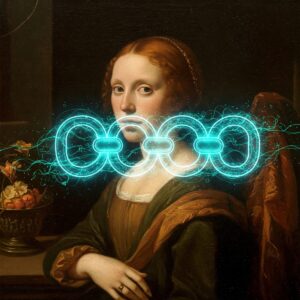
Think of it like a public library of records that everyone can see, but no single person can secretly change. This makes it incredibly trustworthy for recording important information, like who owns a valuable piece of art.
Here’s the cool part:
- Linked Together: Each new note is cryptographically linked to the one before it, creating a chain of blocks (hence, “blockchain”!).
- Super Secure: Because of this linking and complex math (cryptography), changing an old note without everyone noticing is practically impossible. It’s an immutable record.
- Shared & Checked: The notebook isn’t stored in just one place. Copies exist on many computers (it’s decentralized). Everyone in the network helps verify new notes, making it transparent and hard to cheat.
Blockchain Art Explained: Solving Ownership and Provenance Problems
The traditional art world has always faced challenges with proving authenticity and tracking history. Is that painting really by Claude Monet? Who owned it 100 years ago? Getting blockchain art explained shows how this technology offers potential solutions.
Untangling Provenance: The Unbreakable History Trail

Provenance is the documented history of an artwork – its chain of ownership. Good provenance significantly boosts an artwork’s value and confirms its authenticity. Traditionally, this involved paper certificates, gallery records, and expert opinions, which could sometimes be lost, faked, or incomplete. This is where “art provenance blockchain” steps in.
- Digital Fingerprints: Blockchain can store a unique digital identity for an artwork. For physical pieces, companies like Artclear use special scanners to capture microscopic details, creating a “digital fingerprint” linked to the blockchain record.
- Timestamped Transactions: Every time the artwork changes hands, the transaction is recorded on the blockchain with a timestamp. This creates a clear, chronological history that anyone can check.
- Fighting Forgery: Because the blockchain record is so hard to fake (immutable ledger), it becomes much harder for fraudsters to pass off copies as originals or invent a fake ownership history. Need more on traditional methods? Check out how experts authenticate artwork scientifically.
“Blockchain technology […] offers a secured ‘digital passport’ that contains all pertinent information
regarding the artwork’s history and previous transactions.”
Center for Art Law
Defining Ownership in the Digital Age: Enter NFTs
Ownership is straightforward with a physical painting – you hang it on your wall. But what about digital art? How do you “own” a file that can be copied perfectly millions of times? This is where Non-Fungible Tokens (NFTs) come in – a major application you need to understand to have blockchain art explained fully.
- What’s an NFT? Think of an NFT as a unique digital certificate of authenticity and ownership, registered on the blockchain. “Non-fungible” just means it’s one-of-a-kind and can’t be swapped for an identical item (like swapping one dollar bill for another). A specific NFT represents ownership of a specific asset, like a piece of digital art. Learn more about NFT Art here.
- Digital Scarcity: NFTs allow artists to create verifiable scarcity for their digital work. Even if the image file gets copied, only one person can own the official NFT linked to it on the blockchain.
- Smart Contracts: NFTs often use “smart contracts” – bits of code stored on the blockchain. These contracts can automatically handle tasks. For example, an artist can program a smart contract so they automatically receive a percentage (royalty) every time their NFT artwork is resold in the future! This is a game-changer for artists’ earnings.
How NFTs Work (Simplified):
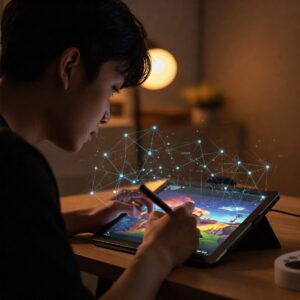
| Step | Action | Blockchain Role |
|---|---|---|
| Creation | An artist creates digital art. | – |
| Minting | The artist “mints” the art as an NFT on a platform (like OpenSea). | A unique token is created on the blockchain, linked to the art. |
| Listing | The artist lists the NFT for sale on a marketplace. | The token’s availability is recorded. |
| Purchase | A collector buys the NFT using cryptocurrency (like Ethereum). | Ownership transfer is recorded indelibly on the blockchain. |
| Resale | The collector resells the NFT. | New ownership recorded; smart contract pays artist royalty. |
The Good, The Bad, and The Techy: Benefits and Challenges
Like any powerful new technology, blockchain in art has exciting advantages but also faces hurdles. Understanding these is key to having blockchain art explained properly.
Benefits:
- Transparency: Transaction histories are often publicly viewable, making the market less opaque.
- Authenticity & Security: Provides strong proof against forgery and theft claims.
- Artist Empowerment: Enables direct sales to collectors, bypassing traditional galleries if desired, and unlocks potential for automatic resale royalties.
- Global Reach: Artists can connect with buyers worldwide through online marketplaces.
- New Art Forms: Encourages experimentation with digital, interactive, and evolving artworks.
- Fractional Ownership: Blockchain makes it easier to sell “shares” of expensive artworks, potentially opening up art investment to more people.
Challenges:
- Environmental Concerns: Some blockchains (especially older ones using “Proof-of-Work”) consume significant amounts of electricity, raising sustainability questions. Newer blockchains are often more energy-efficient.
- Market Volatility: The value of NFTs and cryptocurrencies can swing wildly, making it a risky investment space. What makes any art valuable can be complex – see what makes paintings valuable.
- Complexity & User Experience: Setting up crypto wallets and navigating platforms can be daunting for beginners.
- Regulatory Uncertainty: Governments are still figuring out how to regulate NFTs and crypto, creating legal grey areas.
- Scalability & Fees: Popular blockchains can get congested, leading to high transaction fees (“gas fees”).
- Security Risks: While the blockchain itself is secure, users need to protect their digital wallets from scams and hacking.
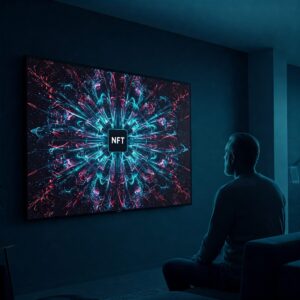
Beyond Digital: Tokenizing Physical Art
Blockchain isn’t just for JPEGs and GIFs! There’s growing interest in using it for physical artworks too. This involves creating a digital token (an NFT) that represents ownership or authenticity of a real-world object.
- Linking Physical and Digital: This often involves securely linking the physical piece to its digital token. Methods include:
- Tamper-proof tags or chips embedded in the artwork.
- High-resolution scans creating unique digital fingerprints (like Artclear’s method).
- Benefits: Allows easier tracking, verification, and potentially fractional ownership of valuable physical art without physically dividing the piece. It adds a layer of digital security and provenance tracking to tangible assets.
What’s Next? The Future of Art and Blockchain
The integration of blockchain into the art world is still evolving, but the potential is huge. Here’s what we might see more of:
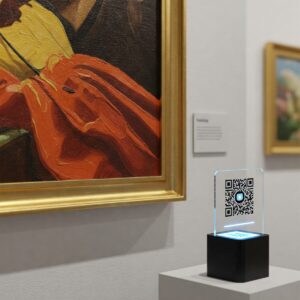
- Improved User Experience: Platforms becoming easier and more intuitive to use.
- Better Scalability & Lower Fees: Newer blockchains and “Layer 2” solutions aiming to make transactions faster and cheaper.
- Increased Regulation: Clearer rules could bring more stability and trust to the market.
- More Sophisticated Smart Contracts: Enabling complex agreements, automatic royalty splits for collaborations, or even artworks that change based on external data.
- Integration with VR/AR: Immersive digital galleries and experiences built around blockchain-verified art. Think virtual art galleries but with proven ownership.
- Greater Crossover: More established galleries and museums experimenting with NFTs and blockchain for collection management, fundraising, or visitor engagement. The Met’s Art Links game is one example.
Conclusion: A New Chapter for Art
Blockchain technology is more than just hype; it’s offering real solutions to age-old problems in the art world while unlocking entirely new possibilities, especially for digital creators. Having blockchain art explained shows us how providing secure, transparent, and verifiable ways to track history and confirm ownership is fundamentally reshaping blockchain art ownership and provenance. While challenges remain, the core ideas – trust through transparency, empowering artists, and bridging the physical and digital – suggest that blockchain will continue to be a powerful force, influencing how art is created, sold, collected, and experienced for years to come. Exploring these changes helps us appreciate the dynamic evolution of art movements happening right now.
Frequently Asked Questions (FAQ)
Q1: What is NFT art? NFT art is essentially digital art (like an image, video, or music file) linked to a unique token (the NFT) on a blockchain. Owning the NFT signifies ownership of the “original” digital piece, verified by the blockchain’s secure ledger. Think of it as a digital certificate of authenticity and ownership rolled into one.
Q2: How does blockchain work for art? Blockchain acts as a secure, shared digital record book. For art, it’s used to:
- Record the creation and unique identity of an artwork (often via NFTs for digital art).
- Track every sale and ownership change, creating a tamper-proof history (provenance).
- Execute smart contracts, for example, to automatically pay artists royalties on resales.
Q3: Is blockchain art a good investment? It can be highly speculative and risky. While some NFTs have sold for millions, values can drop drastically. Like traditional art investment, value depends on factors like the artist’s reputation, the work’s significance, market trends, and collector demand. It’s crucial to research thoroughly and only invest what you can afford to lose.
Q4: How do you prove ownership of digital art? Before NFTs, proving ownership of easily copied digital files was very difficult. NFTs solve this by linking the artwork to a unique token on the blockchain. The person whose secure digital wallet holds that specific NFT is recognized as the owner according to the blockchain record.
Q5: What is provenance in art history? Provenance is the documented history of an artwork’s ownership, custody, and location from its creation to the present day. It helps authenticate the artwork and can significantly impact its value. Traditionally tracked via paper records, blockchain offers a more secure, digital way to manage provenance.
Q6: Can NFTs be faked or copied? The NFT token itself on the blockchain is unique and cannot be faked due to cryptographic security. However:
- The linked artwork (the image/video file) can still be copied like any digital file. Owning the NFT doesn’t stop others from seeing or downloading copies; it signifies ownership of the original tokenized version.
- Scammers might try to sell NFTs linked to art they don’t have the rights to (copyright infringement) or create fake projects. Due diligence is essential.
Q7: What are the top NFT marketplaces? Some well-known NFT marketplaces include OpenSea, Foundation, SuperRare, and Nifty Gateway. Different platforms may specialize in different types of art or have different curation standards.
Q8: How do artists make money from NFTs? Artists can earn money through:
- Primary Sales: Selling their newly minted NFT directly to the first collector.
- Royalties: Receiving a pre-set percentage (e.g., 5-10%) automatically via smart contracts every time their NFT is resold on the secondary market. This provides ongoing income potential.


